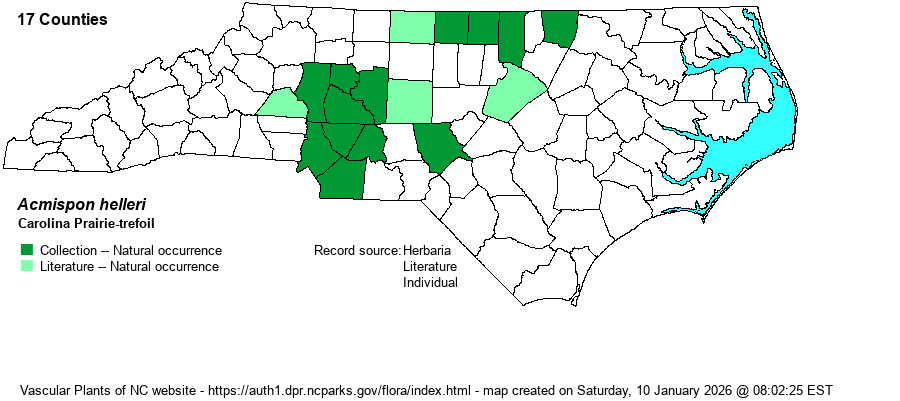| Author | (Britton) Heller | |
| Distribution | Strictly within the Piedmont, one of the relatively few species limited to this middle province in the state. Absent from the western foothills, but ranges east essentially to the Fall Line.
This is a Piedmont endemic species, ranging north only to southern VA and south through the Carolinas into northeastern GA. | |
| Abundance | Uncommon in the south-central Piedmont, from Davidson and Iredell counties to the SC line, but mostly rare to locally uncommon elsewhere, mainly in the VA border counties from Caswell to Granville. This is a State Threatened species. | |
| Habitat | This is a species of dry to somewhat mesic grassy openings in deciduous woods, glades, wooded margins, and other similar places (such as powerline clearings and railroads), mainly where frequently burned or where the soil is clayey and poorly drained. In some places it does show an affinity for somewhat high pH soils, but it is not limited to such "prairie-like" sites. | |
| Phenology | Blooms mainly in July and August, rarely from June into early September. It fruits shortly after flowering. | |
| Identification | This is a slender but moderately branched deciduous herb that grows to about 1 foot tall, with several virgate branches in the upper 1/2 to 2/3 of the plant. It has 3 narrow leaflets per leaf, and each leaflet is only about 1/2-inch long and just 1/5-inch or less wide. (They may remind you of a Desmodium or Lespedeza species.) The many flowers tend to grow singly from leaf axils, each one on a fairly long stalk to about 2/3-inch; the mainly pink flowers (the standard is pink and the wings yellowish tinged with pink) are about 1/4-inch long. The singly-growing flowers on "long" stalks will separate this species from species in Desmodium and Lespedeza. Also very helpful in identification are the quite long, straight, and very slender legumes, each about 1.3 inches long but extremely narrow. Biologists who are familiar with this species can probably identify a plant without flowers or fruit, but in general it is best to have the pink flowers or the long slender pods present to be sure that you have this scarce species. As some populations grow along roadsides and roadbanks, management of the species (such as avoidance of mowing in the growing season) or use of prescribed burns is often needed to maintain healthy populations. | |
| Taxonomic Comments | Many older references had the species placed in the genus Lotus, as Lotus helleri, such as the named used in RAB (1968). Some also had it lumped into the very widespread and mainly Western and Midwestern Lotus americanus = purshianus = unifoliatus. In fact, many references still have it lumped as a variety into this larger species, whatever name you want to call it -- including as Acmispon whatever! In general, people who know this species well from the Piedmont are quite aware this is a distinct species, but NatureServe names it as Lotus unifoliatus var. helleri. This is the reason there is a Q on the global rank, in fact they give it a Global Rank of G5T3, which translates in this website (using Weakley's 2018 taxonomy) as G3Q.
| |
| Other Common Name(s) | Heller's Birdfoot-trefoil, Carolina Birdfoot-trefoil | |
| State Rank | S3 | |
| Global Rank | G5T3 [G3] | |
| State Status | T | |
| US Status | | |
| USACE-agcp | | |
| USACE-emp | | |

